CVTE
Architectural & Mechanical Design
Jeff Wildrick, Academy A Administrator – Ext. 291
Course & Program of Studies
Statement of Purpose
The Architectural and Mechanical Design program at Greater New Bedford Voc-Tech High School provides a strong foundation in design and engineering principles. This program equips students with the skills and knowledge necessary to pursue careers in architecture, interior design, engineering, and related fields.
Key Program Areas:
- CAD Software: Students learn to use industry-standard CAD software, such as AutoCAD, Chief Architect, and Revit, to create detailed drawings and models.
- Architectural Design: Students learn the principles of architectural design, including space planning, building codes, and construction materials.
- Interior Design: Students learn the principles of interior design, including color theory, furniture layout, and material selection.
- Structural Design: Students learn the basics of structural engineering, including load calculations and structural analysis.
- Technical Drawing: Students develop skills in technical drawing, including orthographic projection, isometric drawing, and sectioning.
- Construction Math: Students apply mathematical concepts to solve real-world design problems.
Program Outcomes:
- Technical Proficiency: Students will develop strong technical skills in CAD software and design principles.
- Problem-Solving and Critical Thinking: Students will learn to analyze problems and develop creative solutions.
- Communication Skills: Students will be able to communicate design ideas effectively through drawings and presentations.
- Career Readiness: Students will be prepared for further education or careers in architecture, interior design, engineering, or related fields.
By the end of the program, students will have a strong understanding of the design process and the ability to create detailed and accurate technical drawings. They will be well-prepared to pursue advanced studies or enter the workforce.
Exploratory Program
The Freshman Exploratory program offers a comprehensive introduction to the world of architectural design. Through a series of hands-on projects, students gain exposure to fundamental design principles and software tools.
Key Activities:
- Day 1 – 2D Drawing:
- Learning basic AutoCAD commands to create 2D shapes and drawings.
- Practicing precision and accuracy in drafting.
- Day 2 – 3D Modeling- Hillside Contemporary:
- Using 3D modeling software (Chief Architect) to create a 3D model of an existing building’s interior.
- Applying principles of space planning and interior design.
- Experimenting with different design styles and materials.
- Day 3 – 3D Modeling- NYC Skyscraper Apartment:
- Designing a skyscraper top-floor apartment. Students design a one-bedroom apartment featuring a galley kitchen, dining area, living area, and full bath. They have complete control over the interior design, customizing the apartment to their preferences.
Learning Objectives:
- Develop a basic understanding of architectural design principles.
- Gain hands-on experience with CAD software.
- Learn to think critically and solve design problems.
- Develop spatial reasoning and visualization skills.
- Explore the creative aspects of design.
By the end of the program, students will have a solid foundation in architectural design and be able to make informed decisions about their future academic and career paths.
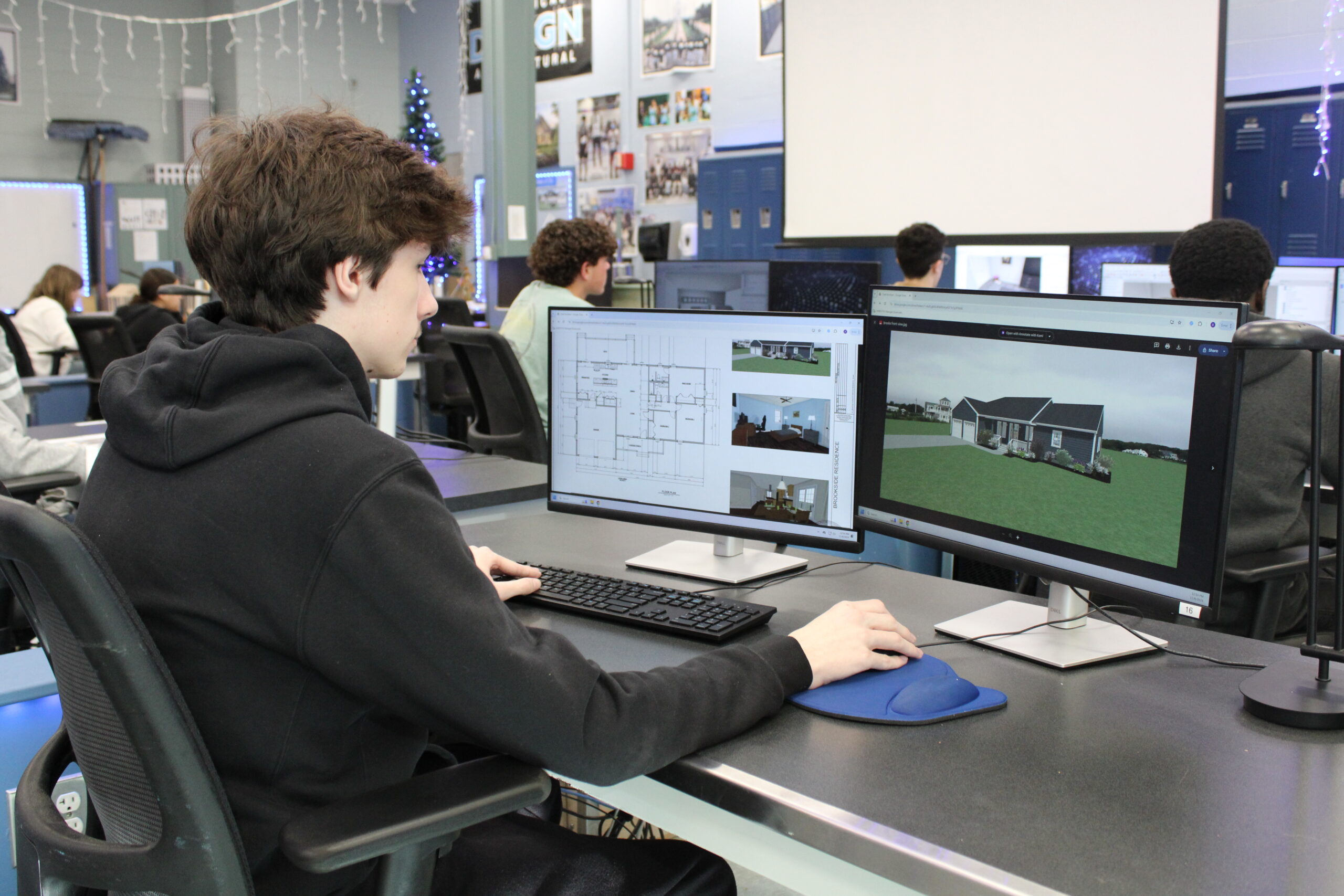
Freshman Program
The Freshman Architectural and Mechanical Design program provides a solid foundation in the fundamentals of design and engineering. Key components of this program include:
Introduction to Design Principles:
- Technical Drawing: Learning the basics of technical drawing, including orthographic projection, isometric drawing, and sectioning.
- Sketching: Developing sketching skills to quickly visualize and communicate design ideas.
- Design Thinking: Applying design principles to solve problems and generate innovative solutions.
CAD Software:
- AutoCAD: Learning the fundamentals of AutoCAD, including basic commands, drawing tools, and layer management.
- 3D Modeling: Creating 3D models of objects and structures using Chief Architect software.
Model Making:
- Foam Core Modeling: Building physical models to visualize design concepts and understand spatial relationships.
- Model Building Techniques: Learning techniques for cutting, shaping, and assembling model components.
Career Exploration:
- Industry Research: Exploring career opportunities in architecture, engineering, and related fields.
- Industry Professionals: Interacting with industry professionals to gain insights into the field.
By the end of the freshman year, students will have a strong foundation in design principles, CAD software, and model-making techniques. They will be well-prepared to advance to more complex projects in the sophomore year.
Sophomore Program
The Sophomore Architectural and Mechanical Design Program focuses on introducing students to foundational design and construction principles through Building Information Modeling (BIM) technology using Chief Architect software. Throughout the year, students develop the skills necessary for understanding residential construction and producing professional-level design work. Key components of the program include:
- Introduction to BIM Technology and Chief Architect Software: Students learn to use Chief Architect, a professional design tool, to recreate an existing house, practicing core software skills.
- Residential Construction Basics: Understanding foundations, floor, wall, ceiling, and roof framing.
- Sizing basic structural members: Students learn the fundamental calculations determining the correct size for structural elements.
- Construction Drawing Creation: Students complete a full set of construction drawings for a small house, incorporating details learned from earlier in the program.
- Basic Kitchen and Bath Design: Adhering to the National Kitchen and Bath Association (NKBA) standards for kitchen and bathroom design. Students practice NKBA-compliant drawing standards for scale and dimensioning.
- First House Design Project: Students engage in their first attempt at designing a small house from scratch, applying all the principles learned thus far.
The goal is for students to develop the necessary software skills and design knowledge to be well-prepared for their junior year, where they will take on more complex design challenges.
In addition, students receive training in the Occupational Safety and Health Administration (OSHA) 10-hour Construction Course.
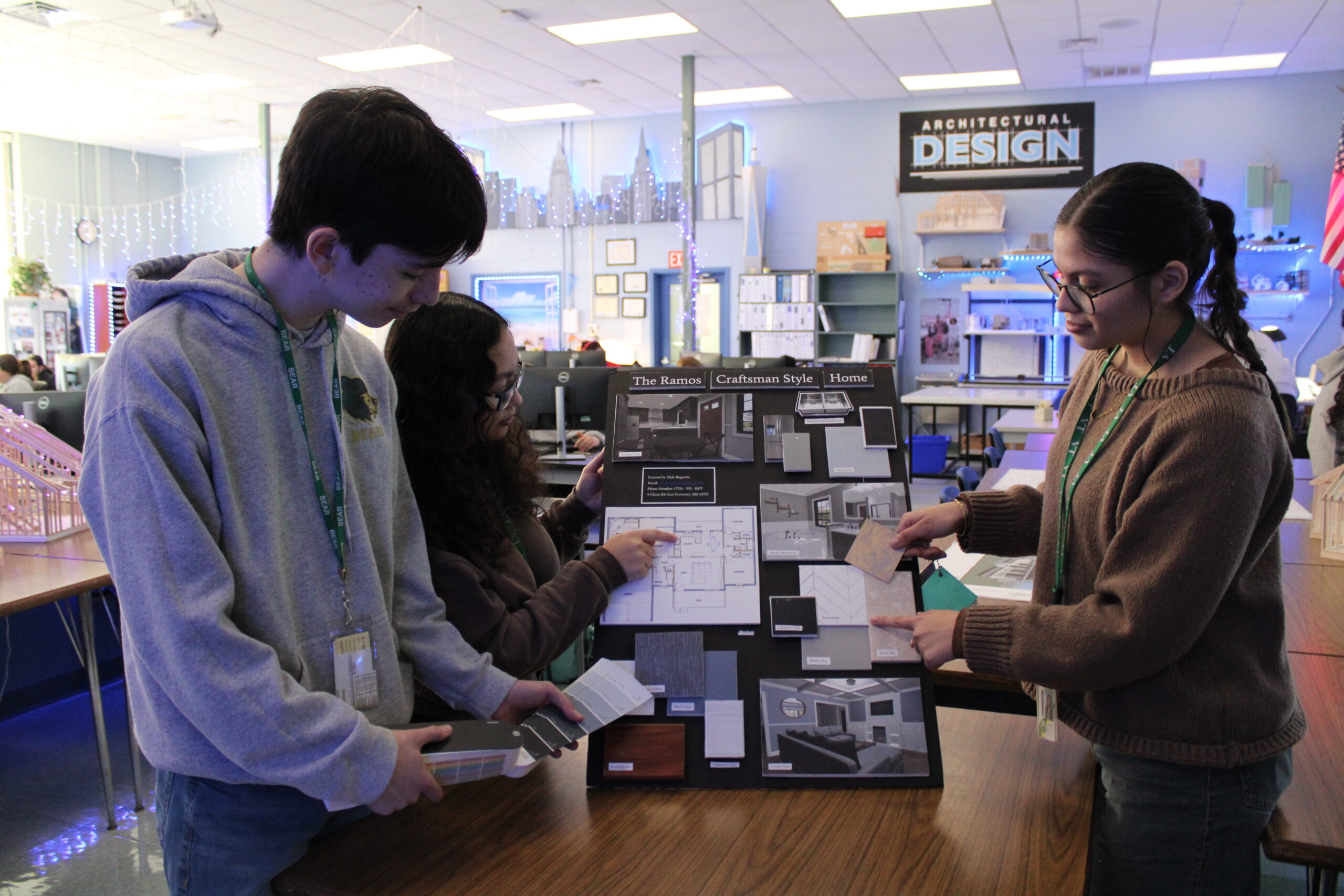
Sophomore Related 1
Drafting Tech Science II
The Drafting Tech Science II curriculum provides students with training in architectural lettering, orthographic projection, pictorial drawings, proper dimensioning techniques, architectural and mechanical symbols, and basic residential structures. Students will also develop basic manual drafting and visualization skills, and solve spatial problems. Additionally, they will develop interpersonal, written, and communicative skills that they would encounter in the everyday workforce.
Students will demonstrate Proficiency in:
- Building and Interior Codes
- Reading a Tape Measure
- Architectural & Mechanical Symbols
- Floor Plan Design
- Basic Kitchen Designs
- Basic Space Planning
Sophomore Related 2
Drafting Tech Math II
The Drafting Tech Math II curriculum provides students various aspects of drafting technology through practical and realistic mathematical problems they may encounter in everyday work situations. This course equips students with the technical skills required to succeed in the field of drafting technology.
Students will demonstrate Proficiency in:
- Reading Architectural & Mechanical Scales.
- Basic Geometry
- Basic Algebra
- Basic Statistics
- Basic Estimating
Junior Program
The Junior Architectural and Mechanical Design Program provides a comprehensive curriculum to equip students with a solid understanding of graphic language and technical design. Students will explore the fundamental principles of drafting, learning how to translate complex ideas into precise technical drawings using modern CAD techniques and software. The program introduces essential tools, such as AutoCAD and Chief Architect, which are crucial in the fields of architecture and design.
This curriculum emphasizes real-world applications and critical thinking, equipping students with the skills needed for higher education and careers in architecture, interior design, civil engineering, and structural engineering.
Key Components of the Program:
- Residential Design: Mastering the design and layout of residential spaces using Chief Architect software.
- Interior Design: Designing interiors, including room layouts, with an eye for both form and function.
- Floor Plan Design: Students will learn to create floor plans that meet both aesthetic and functional requirements.
- Principles of Construction: Gaining knowledge of construction methods and practices.
- Foundation Design: Understanding the design of foundations, ensuring stability and compliance with regulations.
- Wall, Floor, and Roof Framing Plans: Drawing framing systems for walls, floors, and roofs, with attention to structural detail.
- Elevation Drawings: Creating detailed elevation drawings for residential exteriors.
- Renovation and Remodeling: Learning techniques for updating and remodeling existing structures.
- Interior and Building Codes: Familiarizing with codes and standards for interior spaces and overall building safety.
- Small-Scale Model Making: Creating scaled models to visualize designs in a tangible form.
- Structural Math and Calculations: Applying mathematical principles to ensure structural integrity.
- Basic Electrical and Plumbing Design: Designing essential systems for residential buildings, including electrical and plumbing layouts.
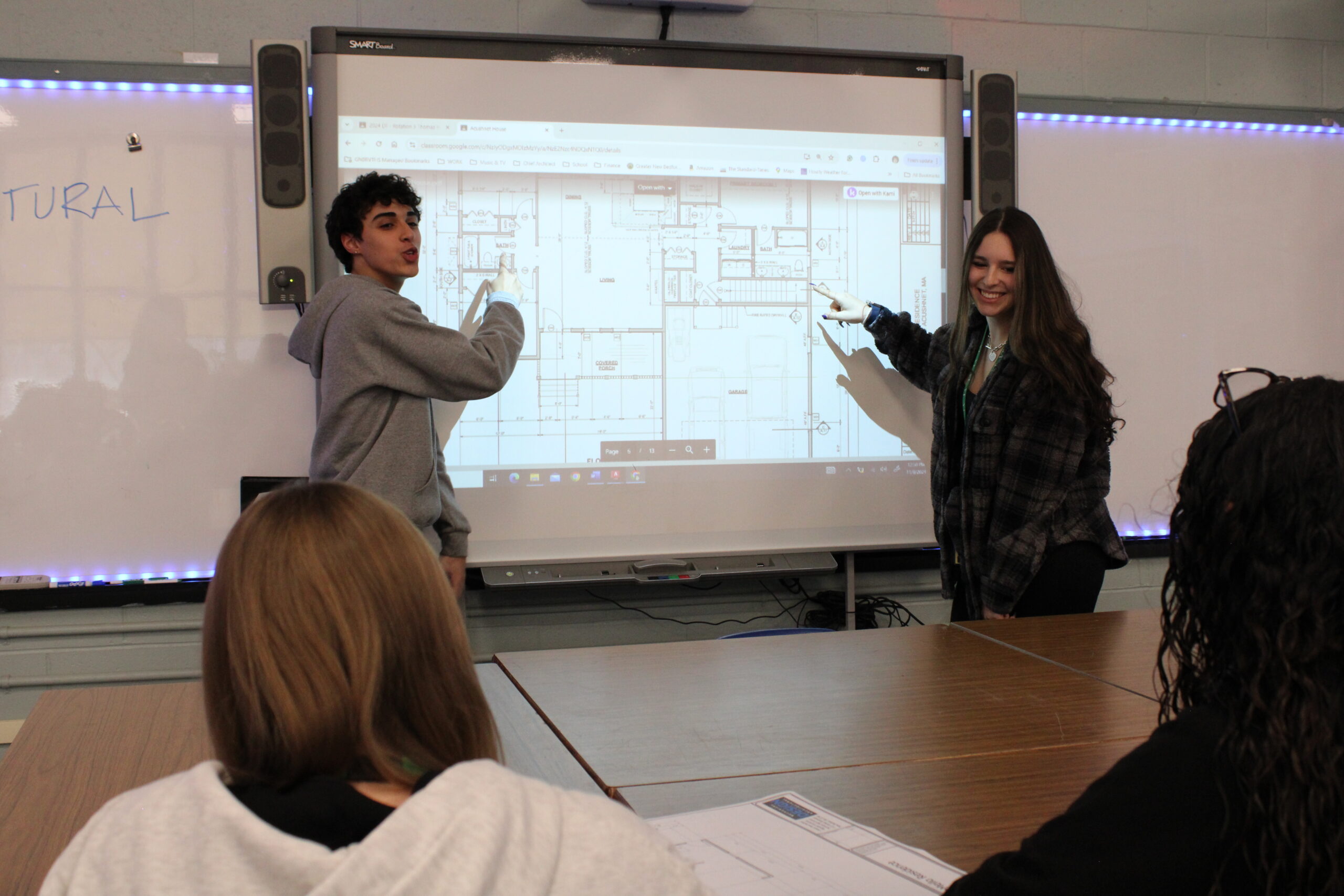
Junior Related 1
Basic Building Design III
The Junior Basic Building Design III curriculum provides the students with the basic knowledge and understanding of how to apply basic trade math to the design and construction of a building. The student will develop basic trade math skills using the principles of construction and structural design. Students are taught structural calculations using measurement, geometry, and algebra. These are the skills that they would encounter in the everyday workforce and beyond.
Students will demonstrate Proficiency:
- Basic geometry (Perimeter, Area, Volume as it relates to solving for foundation/footing/patios)
- Basic algebra (Using word problems, fractions, and percentages as they relate to construction math)
- Reading Tools of Measurements (as it applies to drafting and designing)
- Personal Finances (as it relates to owning a business, budgets, pricing, and income)
- Practical Math (as it relates to measurements metric standards in construction and conversion).
- Pythagorean theory as it relates to roof design
- Sustainable Design & Design Styles
- The Building Design Process
Junior Related 2
Basic Design Science III
The Junior Basic Design Science III curriculum provides the students with the basic knowledge and understanding of how to apply the principles of construction to a design, develop an understanding of basic structural design, and apply design theory and space planning to a building. The student will develop basic (manual) drafting and visualization skills, and solve spatial problems, develop interpersonal, written, and communicative skills that they would encounter in the everyday workforce.
Students will demonstrate Proficiency in:
- Knowledge of the principle of construction.
- Knowledge of Renovation and Remodeling.
- Drawing elevations
- Foundation design.
- Drawing wall framing systems as well as floor and roof framing plans.
- Knowledge of Interior/building codes
- Interior design, including space planning and color theory.
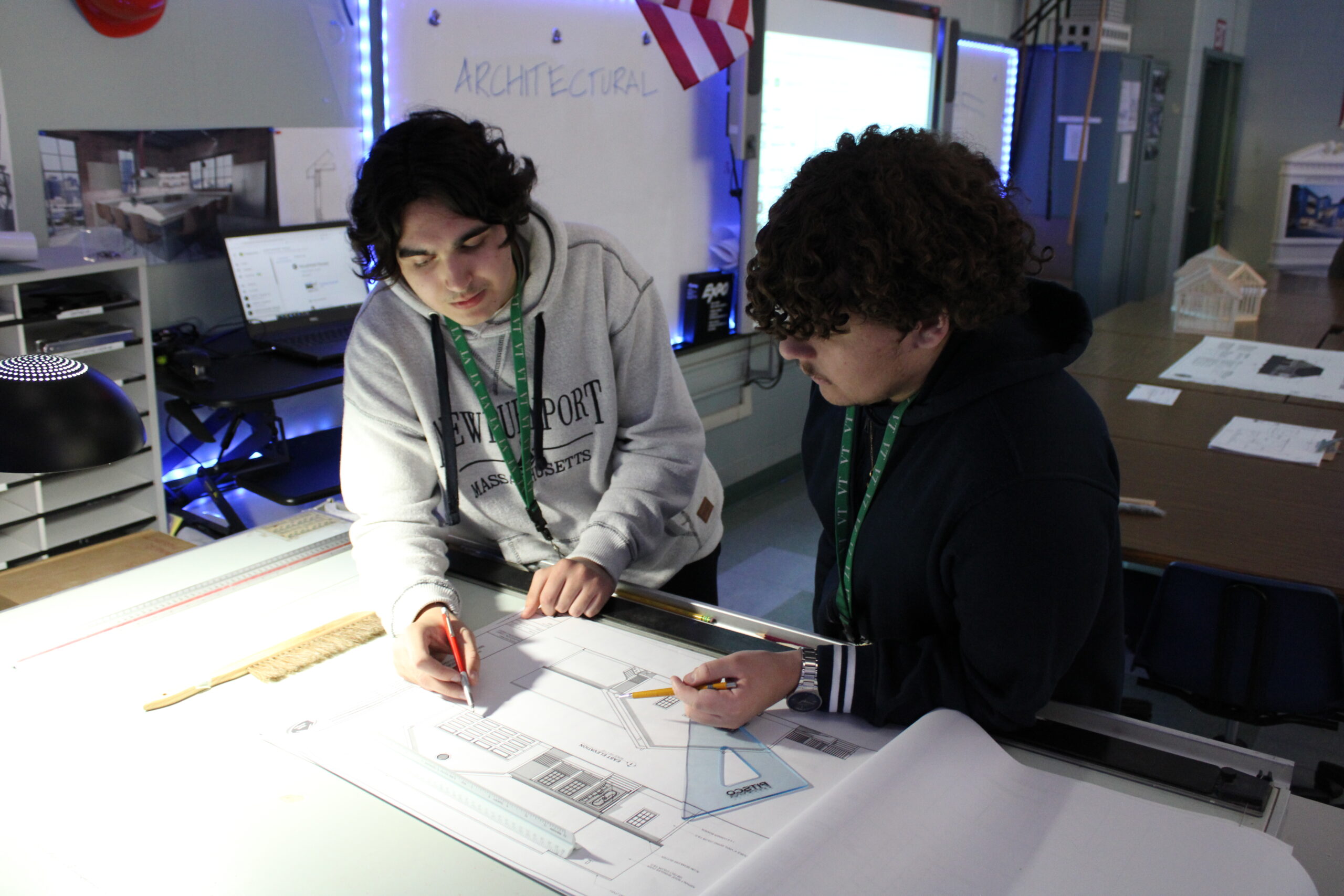
Senior Program
The Senior Architectural and Mechanical Design Program builds on the foundational knowledge acquired during the first two years, enabling students to take on more complex and comprehensive projects. This advanced curriculum emphasizes real-world applications and critical thinking, equipping students with the skills needed for higher education and careers in architecture, interior design, civil engineering, and structural engineering.
Key Components of the Program:
- Revit Software Training: Students gain proficiency in Revit, a leading software tool widely used for architectural design and building information modeling in college and professional settings.
- Commercial and Residential Design: The curriculum covers both commercial and residential design principles, equipping students with the skills to approach various project types effectively.
- Introduction to Civil and Structural Engineering: Students receive foundational knowledge in civil engineering and structural engineering, focusing on the principles that govern building design and construction.
- Advanced Floor Plan Design: Participants will learn to create intricate floor plans that meet both aesthetic and functional requirements.
- Large-Scale Model Making: Emulating collegiate standards, students will engage in large-scale model making, enhancing their understanding of spatial relationships and design elements.
- Structural Math and Calculations: The program includes essential mathematical concepts and structural calculations necessary for evaluating material strength and structural integrity.
- Building Codes and Regulations: Students will familiarize themselves with building codes and regulations to ensure compliance and safety in their designs.
- Strength of Materials: An exploration of material properties and behavior under various loads prepares students for real-world engineering challenges.
This program is tailored to ensure students are well-prepared for collegiate-level education and future careers in architecture, interior design, civil engineering, and structural engineering and is nationally certified by the American Design Drafting Association (ADDA).
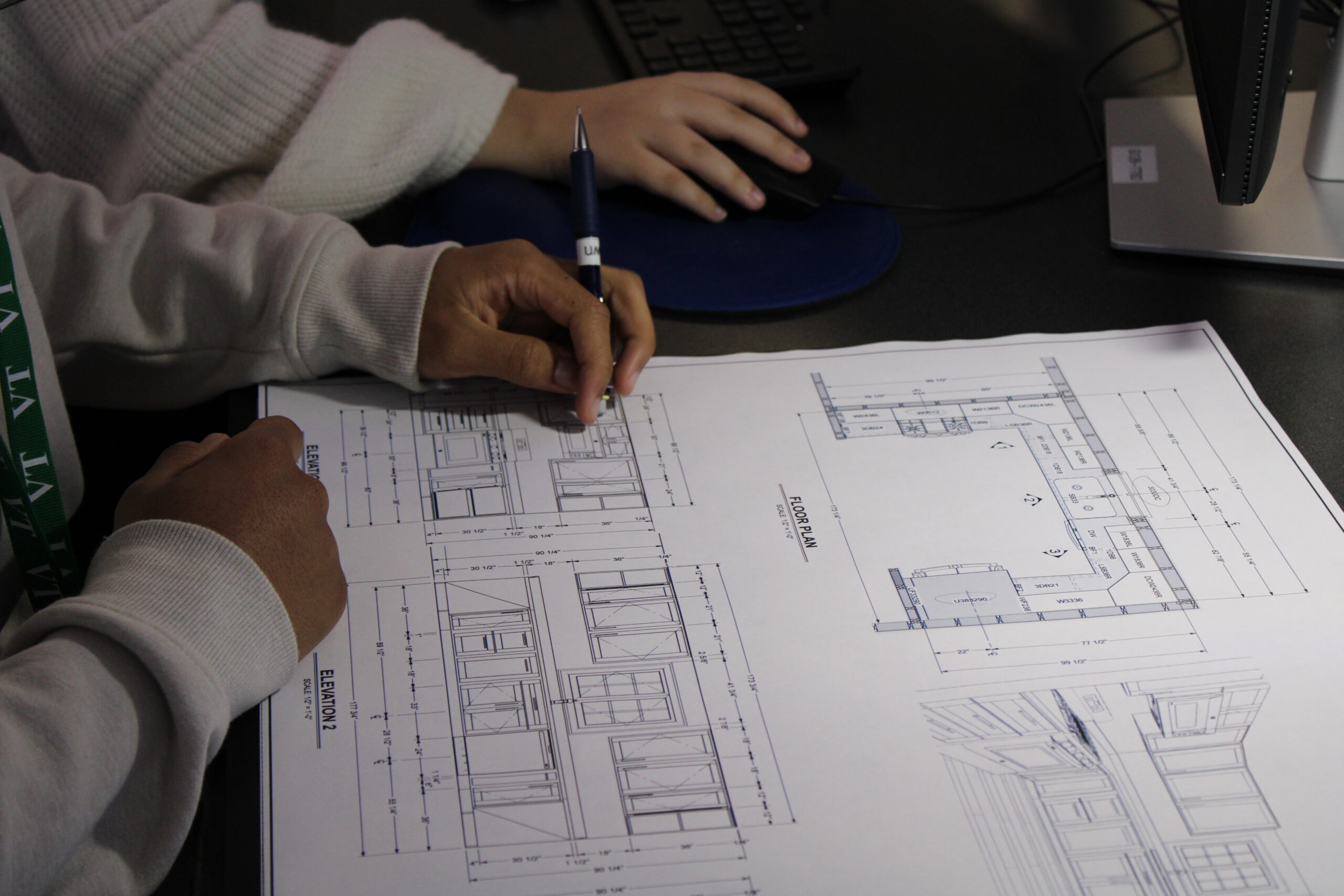
Senior Related 1
Advance Design Science
The Senior Advance Design Science IV program provides students with the advanced skills and knowledge needed to prepare for careers in architecture and engineering. Key areas of focus include:
Construction Document Preparation:
- Architectural Drawings: Creating detailed architectural drawings, including floor plans, elevations, sections, and details.
- Structural Drawings: Develop structural drawings, including foundation plans, framing plans, and structural details.
- Mechanical Drawings: Creating mechanical drawings, including HVAC, plumbing, and electrical systems.
- Electrical Drawings: Developing electrical drawings, including lighting plans, power plans, and circuit diagrams.
Project Management:
- Scheduling: Developing project schedules and timelines.
- Budgeting: Estimating project costs and managing budgets.
- Coordination: Coordinating with other design team members, such as engineers and contractors.
Building Codes and Standards:
- Building Codes: Understanding and applying building codes and standards.
- Accessibility Standards: Designing accessible buildings and spaces.
- Sustainability: Incorporating sustainable design principles into projects.
Professional Practice:
- Communication Skills: Effectively communicating with clients, contractors, and other professionals.
- Presentation Skills: Developing and delivering professional presentations.
- Ethical Considerations: Understanding ethical principles in the design profession.
By the end of this course, students will be well-prepared to enter the workforce or pursue further education in architecture, engineering, or related fields. They will have the skills and knowledge to create high-quality design documents and manage complex design projects.
Senior Related 2
Basic Engineering Design
The Senior Basic Engineering Design IV program provides students with a solid foundation in practical engineering skills and business knowledge. Key areas of focus include:
Financial Management:
- Budgeting: Creating and managing budgets for projects.
- Cost Estimating: Estimating material costs, labor costs, and overhead expenses.
- Financial Analysis: Analyzing financial data to make informed decisions.
Structural Analysis:
- Basic Structural Calculations: Performing simple structural calculations, such as load calculations and stress analysis.
- Material Selection: Choosing appropriate materials for specific applications.
- Structural Design: Designing simple structures, such as beams and columns.
Construction and Manufacturing:
- Shop Practices: Using various tools and equipment to fabricate components.
- Material Estimation: Estimating the quantity of materials needed for a project.
- Quality Control: Ensuring the quality of work through inspection and testing.
- Safety Practices: Adhering to safety regulations and using personal protective equipment.
Communication and Professional Skills:
- Technical Writing: Writing clear and concise technical reports and documentation.
- Presentation Skills: Effectively communicating design ideas and project updates.
- Teamwork and Collaboration: Working effectively with others to achieve project goals.
- Problem-Solving and Critical Thinking: Applying problem-solving and critical thinking skills to engineering challenges.
By the end of this course, students will be well-prepared to enter the workforce or pursue further education in engineering or related fields. They will have a strong foundation in technical skills, financial management, and professional communication.
Certifications
Architectural
- Occupational Safety and Health Administration (OSHA)
- The ADDA Drafter Certification Examination (optional)
- The Autodesk® Certified User exam – 2D AutoCAD
Mechanical Drafting
- Career Safe Certification, recognized by the Occupational Safety and Health Administration (OSHA)
- Certified Solidworks Associate Exam 3D modeling
- The Autodesk® Certified User exam – 2D AutoCAD
- The ADDA Drafter Certification Examination-Certified Mechanical Drafter
Career Opportunities
Architectural
-
With a Two year Option
– Associate of Science Degree
- Architectural drafters – create diagram features of buildings, both structural and architectural, used in construction jobs.
- Electrical drafters – create diagrams that lay out wiring setups. These diagrams are used by professionals who repair and install electrical equipment and wiring.
- Mechanical drafters – prepare detailed assembly drafts for use with mechanical devices and machines. These drawings include methods of fastening, dimensions and other specifications.
- Civil drafters – create topography and relief maps for use in civil engineering projects. These projects include bridges, water and sewage systems, highways and flood control setups.
- Electronics drafters – diagram schematics for assembling circuit boards and wiring for use in electronic device manufacturing and repair.
With a Four Year Option plus option
– Bachelor of Science, Master’s Degree
- Architect- plans, designs, and reviews the construction of buildings for the principal purpose of human occupancy or use.
- Civil Engineer-deals with the design, construction, and maintenance of the physical and naturally built environment, including works like roads, bridges, canals, dams, and buildings.
- Construction Managers- oversee the planning, design, and construction of a project, from its beginning to its end.
- Electromechanical Engineer- Evaluates electrical systems and products components
- Interior Designer- makes interior spaces functional, safe, and beautiful.
- Industrial Designer-develop concepts and designs for manufactured products or housewares.
- Landscape Architect- oversees site analysis, site inventory, land planning, planting design, grading, stormwater management, sustainable design.
- Mechanical Engineer – applies the principles of engineering, physics, and materials science for the design, analysis, manufacturing, and maintenance of mechanical systems.
Mechanical Drafting
- Detail Draftsperson
- Engineering Assistant
- CAD Detailer
- Mechanical Drafter
- Mechanical Designer
- Civil Drafter
- Electrical Drafter
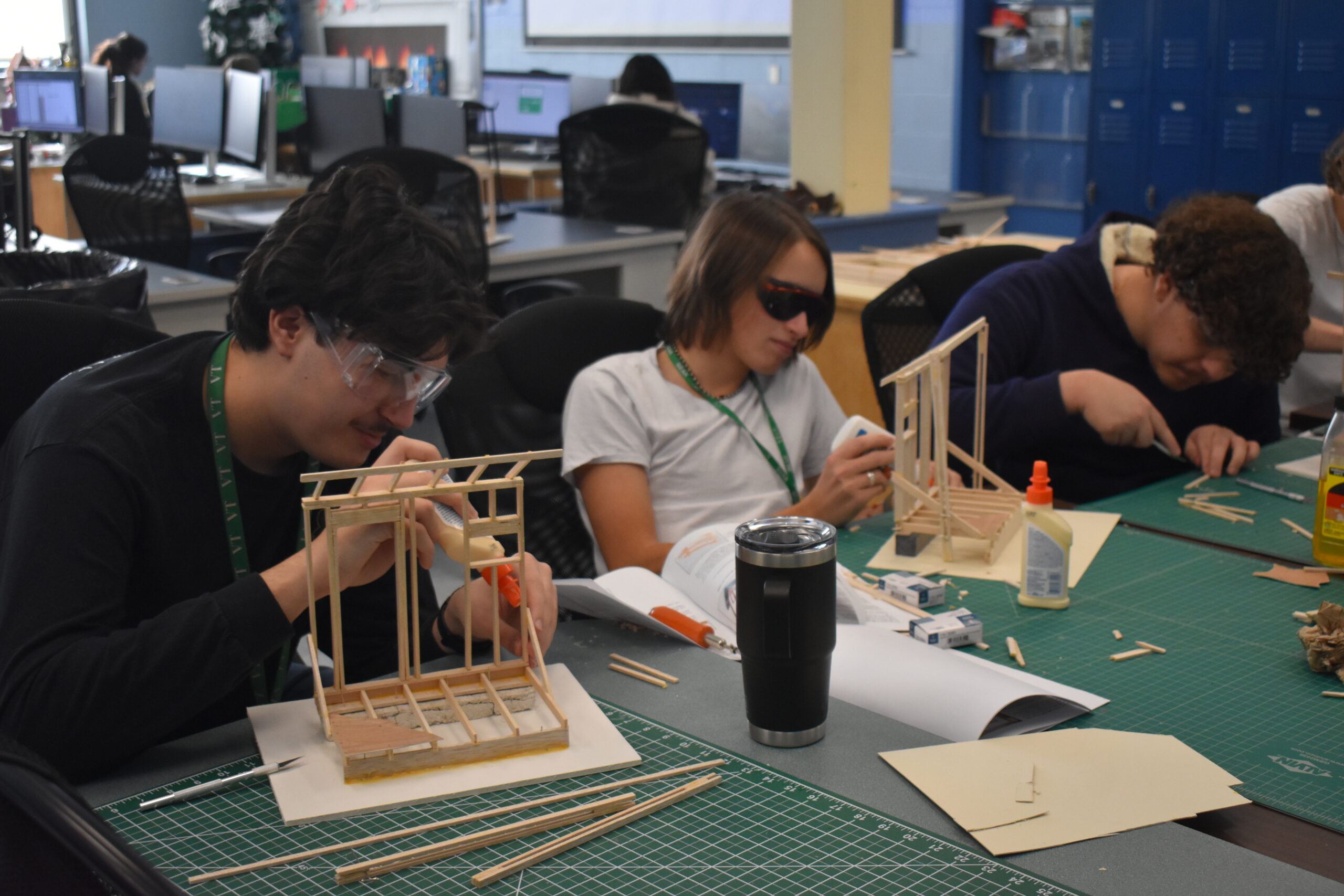
Post-Secondary Education
Architectural
Upon completion of this Technical Program students will be better prepared for college to receive a degree in either options of an Associate of Science Degree or a Bachelor of Science that could lead to further studies with a Master’s Degree in the trade.
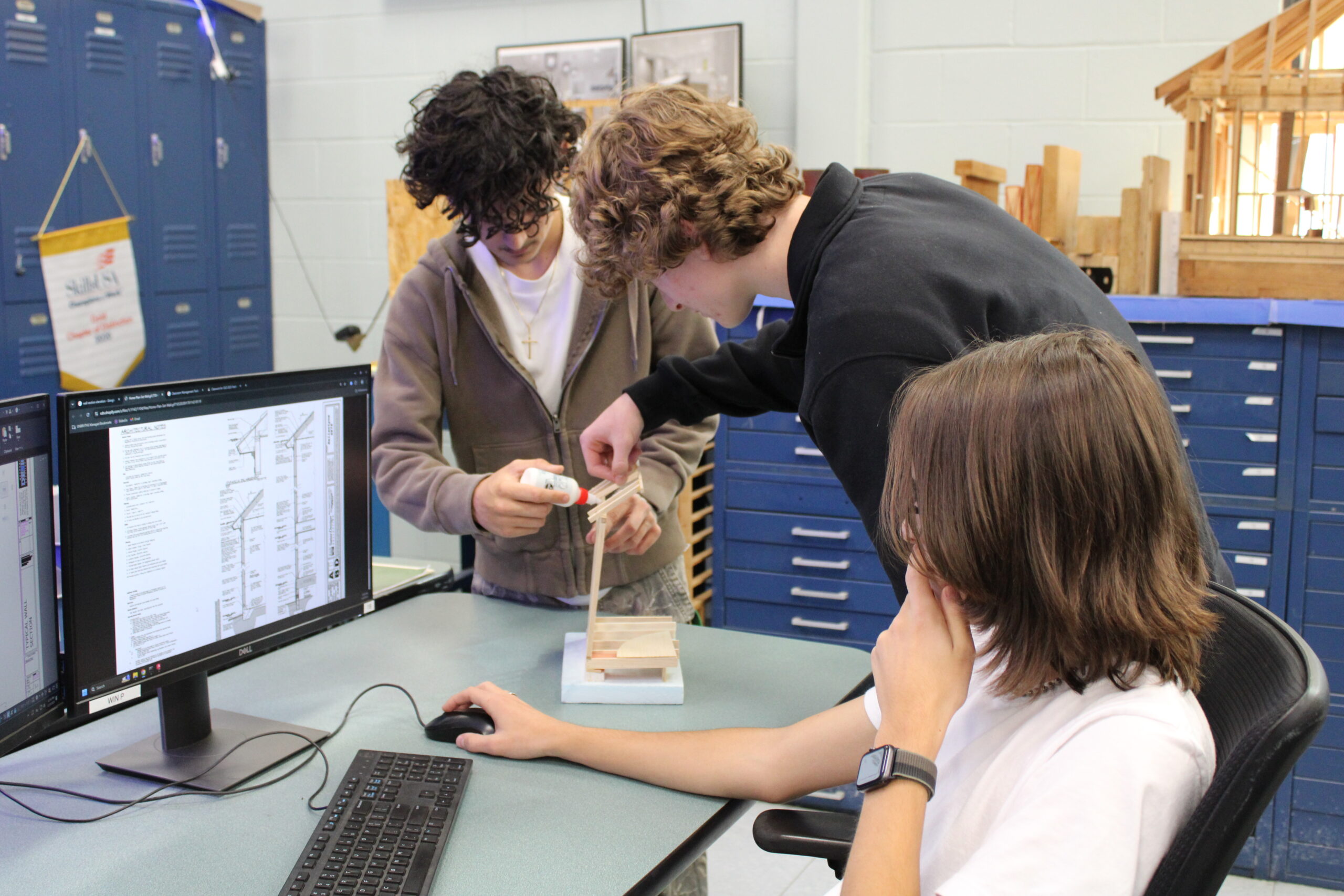
Mechanical Drafting
Upon completion of this Technical Program, students will be better prepared for postsecondary education (college) in the following courses of study:
Two or four year options in:
- Manufacturing Technology
- Electro-mechanical Technology
- Industrial Engineering Technology
- Mechanical Engineering Technology
- Industrial Design


